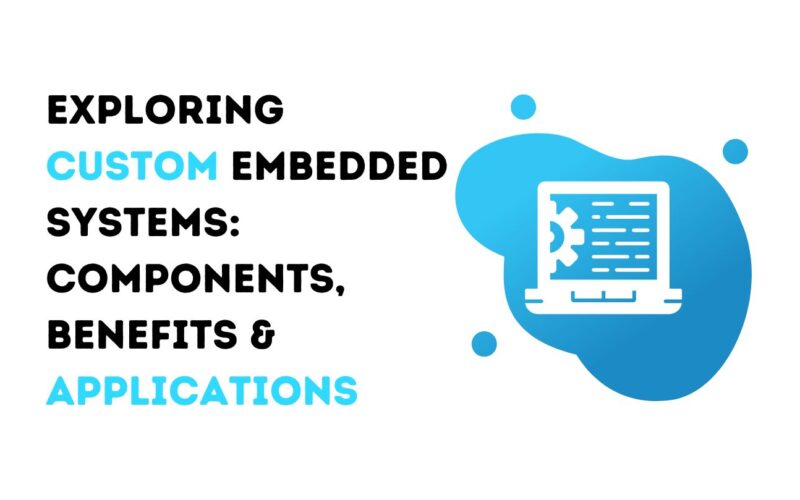Embedded systems are specialized computing systems designed to perform specific tasks within larger systems. They are ubiquitous, powering everything from household appliances to advanced industrial machinery.
Custom embedded systems take this concept a step further, providing tailored solutions for unique applications. This article explores the world of custom embedded systems, their components, benefits, and real-world applications.
What is a Custom Embedded System?
A custom embedded system is a bespoke computing solution engineered to meet the specific needs of a particular application. Unlike off-the-shelf embedded systems, which offer general functionalities, custom embedded systems are designed from the ground up to optimize performance, efficiency, and functionality for a given task.
Key Components of Custom Embedded Systems

Custom embedded systems typically consist of several core components:
- Microcontroller or Microprocessor: The brain of the system, responsible for executing instructions and managing tasks.
- Memory: Stores code and data required for the system to operate. This includes RAM (for temporary storage) and ROM (for permanent storage).
- Input/Output Interfaces: Facilitate communication with other devices and sensors.
- Power Supply: Provides the necessary power for the system to function.
- Software: Custom firmware or operating systems that control the hardware and provide the necessary functionality.
Designing a Custom Embedded System
Designing a custom embedded system involves several steps:
- Requirement Analysis: Understanding the specific needs of the application.
- System Design: Creating a blueprint that outlines the hardware and software components.
- Prototyping: Building a preliminary version to test and validate the design.
- Development: Writing the software and developing the hardware components.
- Testing and Validation: Ensuring the system meets the required specifications and performs reliably.
- Deployment: Installing the system in its intended environment and ensuring it operates as expected.
Benefits of Custom Embedded Systems
- Optimization: Custom embedded systems are tailored to the specific needs of the application, ensuring optimal performance and efficiency.
- Flexibility: They offer the flexibility to include or exclude features as needed, making them highly adaptable.
- Scalability: Custom systems can be designed to scale with the growth of the application, accommodating future needs.
- Security: Tailored systems often include specific security features to protect against vulnerabilities unique to the application.
- Cost-Effectiveness: While the initial investment might be higher, custom systems can reduce long-term costs by eliminating unnecessary features and optimizing resource use.
Applications of Custom Embedded Systems
Custom embedded systems are found in a wide range of industries, including:

- Automotive: From engine control units to advanced driver-assistance systems (ADAS), custom embedded systems enhance vehicle performance and safety.
- Healthcare: Medical devices such as pacemakers, infusion pumps, and diagnostic equipment rely on custom embedded systems for precision and reliability.
- Consumer Electronics: Smartphones, smart home devices, and wearable technology are powered by embedded systems designed for specific functionalities.
- Industrial Automation: Custom systems control machinery, robotics, and other industrial equipment, improving efficiency and reducing downtime.
- Telecommunications: Network routers, switches, and communication devices utilize custom embedded systems to handle specific data processing tasks.
- Aerospace and Defense: Systems for avionics, navigation, and weaponry are often custom-built to meet stringent performance and reliability standards.
Challenges in Developing Custom Embedded Systems
- Complexity: Designing a system from scratch requires significant expertise in both hardware and software engineering.
- Time-Consuming: The development process, from requirement analysis to deployment, can be lengthy.
- Cost: Initial development costs can be high, particularly for highly specialized applications.
- Risk: There is an inherent risk in developing a new system, as unforeseen issues may arise during development or deployment.
Future Trends in Custom Embedded Systems
- Artificial Intelligence (AI): Integration of AI and machine learning algorithms to enable smarter and more adaptive systems.
- Internet of Things (IoT): Increasing connectivity and communication capabilities between devices.
- Edge Computing: Processing data closer to the source to reduce latency and improve real-time decision-making.
- Security: Enhanced security features to protect against evolving cyber threats.
- Energy Efficiency: Development of systems that consume less power, extending battery life and reducing environmental impact.
Conclusion
Custom embedded systems represent the pinnacle of specialized computing, offering tailored solutions that enhance performance, efficiency, and functionality for specific applications.
From automotive and healthcare to industrial automation and consumer electronics, these systems are crucial in driving innovation and meeting the unique demands of various industries.
Despite the challenges in their development, the benefits and potential of custom embedded systems make them invaluable assets in today’s technology-driven world.
As advancements in AI, IoT, and other emerging technologies continue, the role of custom embedded systems is set to become even more significant, paving the way for smarter, more efficient, and more secure applications.










